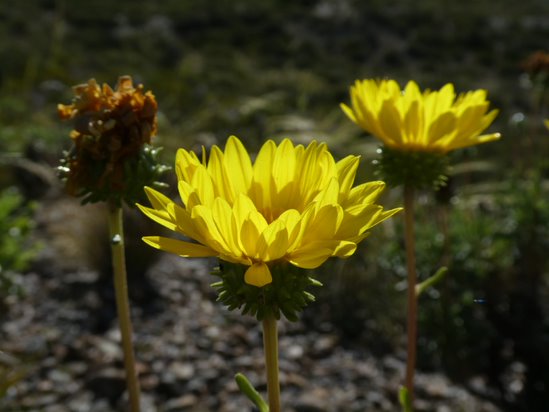
The visit offered WLT a chance to help FPN’s board strengthen its long-term plans to fund conservation of Guanaco (such as this youngster) and others at La Esperanza. Image credit: WLT/Richard Cuthbert
By Richard Cuthbert – WLT’s Director of Conservation.
“Patagonia”. Even the word brings a frisson of excitement: mental images of soaring mountains, vast open landscapes, wild seas and spectacular wildlife.
Only mountains were lacking from the landscape in front of me, but Estancia La Esperanza had the remainder in abundance: a searing blue sea and rhythmic surf crashing onto the beach, desert steppes stretching beyond the eye, and a large herd of Guanacos placidly grazing before departing in an unhurried loping canter.
Estancia la Esperanza covers 6,700 hectares (16,555 acres) and is located in Argentina’s Chubut Province and a short drive (for Patagonia) from the world famous Península Valdés and city of Puerto Madryn where WLT partner Fundacion Patagonia Natural (FPN) is located.

The trip allowed Richard to take stock of La Esperanza’s recovery after a colossal blaze in late 2016, with wildlife shown to be abundant three years later. Image credit: WLT/Richard Cuthbert.
Purchased with WLT support in 2000 la Esperanza was formerly a sheep station, but since its acquisition, FPN and their small team of rangers have been restoring this remote landscape: removing the sheep and internal fences, and allowing the slow-growing desert steppe shrubs and grasses to recover from decades of over-grazing.
With this restoration of the landscape and its ongoing protection came a subsequent increase in numbers of Guanacos, Mara (also known as a Patagonian Hare), Pygmy Armadillo, Lesser Rhea and many other species, in turn, supporting Puma and Patagonian Grey Fox that are still persecuted in the region but which find a safe refuge at la Esperanza.
Fire-hit FPN reserve eyes future of ecotourism
My visit to FPN was not only to visit La Esperanza but also to work with FPN Vice-President Jose Maria Musmeci and other Board members to recruit a new project manager for La Esperanza and to develop and strengthen the long-term plans for the reserve. Successful conservation projects are usually a long-term process and WLT works by not only purchasing and acquiring land, but also by ensuring that our partners have the means for its ongoing protection.
Often this support is from WLT’s Keepers of the Wild fund, where supporters’ donations cover the salaries, patrols and equipment of rangers at our partner’s reserves. However, where there is an opportunity, WLT also works to develop alternative funding mechanisms to ensure a project can become self-sustaining and with FPN we were discussing ideas for revitalising the buildings, infrastructure and promotion of the reserve, so that it can better attract visiting researchers, university groups and tourists, which will provide an income for its long-term management.

Burrowing Owl on a fence post – The Patagonian landscape was one of silence and tranquillity but close up there was movement everywhere and a restless energy, Richard found. Image credit: WLT/Richard Cuthbert.
Of all the management undertaken at La Esperanza the most important is the work of FPN’s two local rangers, Axel Kuchaska and Mark Jones (whose name betrays a Welsh Patagonian ancestry), and whose daily patrols ensure the site is protected. I accompanied Axel for a day of his rounds: driving a patrol across half of the site, stopping to undertake counts of Guanaco and to retrieve memory cards from camera traps, checking the fence lines for any illegal entrances or signs of attempted hunting.
We also looked at the regrowth of the grasses and scrub vegetation that was recovering from an out of control wildfire (started on a property over 30 km away) which had swept through La Esperanza in 2016. Fire remains a key threat here – as with many of our partners’ reserves – but the early signs were that the area was recovering well and wildlife remained abundant.
As frequently during the day, we walked, stopped and just watched: both of us drinking in the site and sounds of the reserve. At a large scale the wide open landscape was one of silence and tranquillity, but close up there was movement everywhere and a restless energy.
From the bolting run of a Mara to the persistent songs of displaying Rufous Collared Sparrows, and a never ending wind sweeping off the sea and sending waves of motion through the grasses and wild flowers and buffeting an otherwise motionless Burrowing Owl whose fire-orange eyes contrasted with the surrounding land. These sites were a daily occurrence for Axel and a too brief but privileged glimpse for me.
World Land Trust needs your help to ensure no reserve suffers what Patagonia’s La Esperanza experienced through the 2016 fire.
By supporting our new Wildfire Appeal, you can fund fire equipment and training for the partners who need it most, giving them a fighting chance in a year when COVID-19 and climate change are closing in on global forests. Donate and make a difference today!
WLT is calling on our supporters to
HELP US GET AHEAD OF THE FLAMES.
Read more about the Wildfire Appeal
A donation to the WLT Wildfire Appeal will enable our partners to provide training for rangers and essential equipment to provide a better outcome for nature reserves around the world.
Support us on our mission to fight forest fires around the world by donating to our Wildfire Appeal today.

